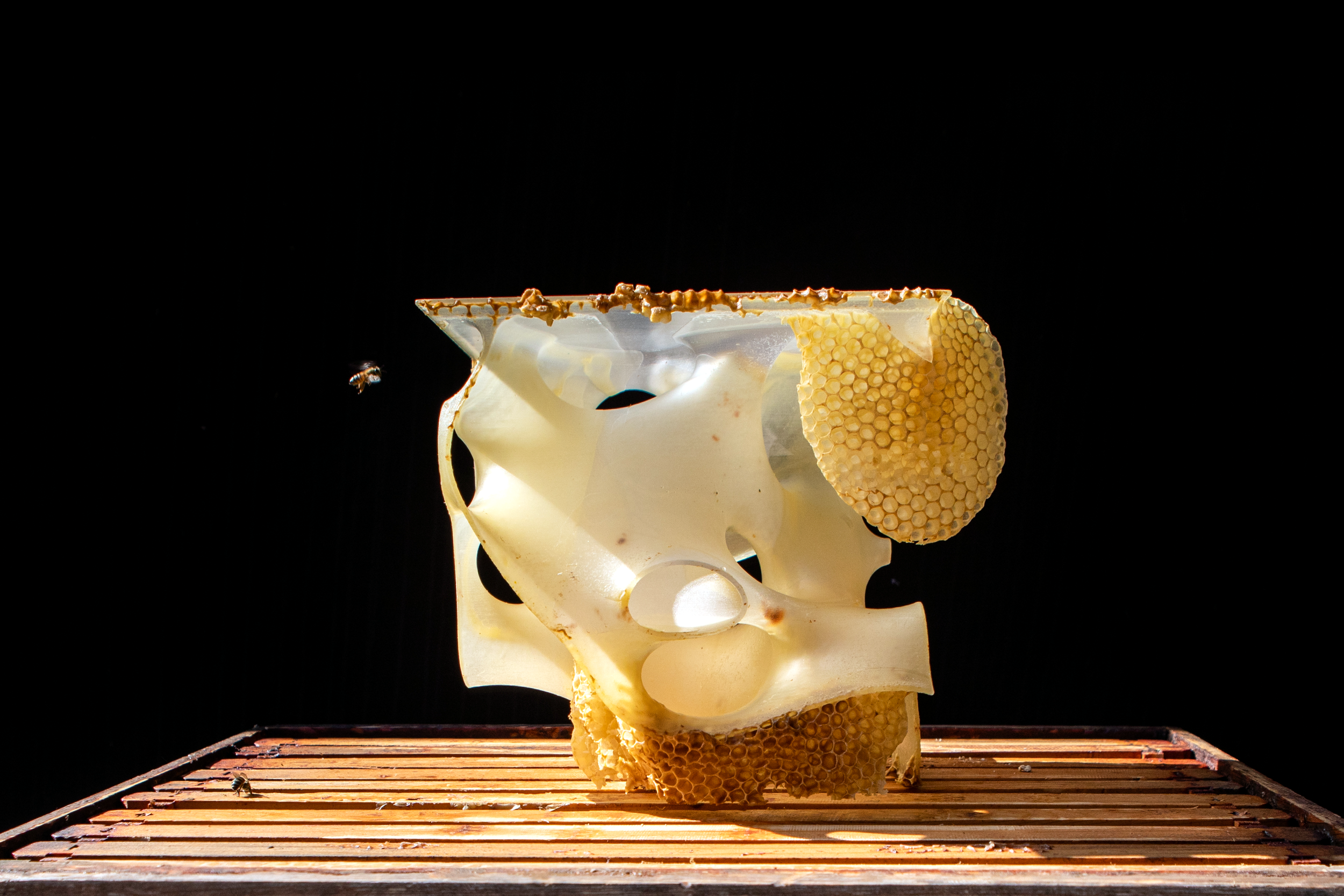
Synthetic Apiary II
Synthetic Apiary II applies computational analysis to understanding the design and architecture of the earth’s most vital pollinators – honeybees.

Motivation
For centuries, the construction of combs by social insects has been endorsed as an archetype of swarm intelligence and self-organization. The architecture of honey bee combs embodies a range of expressions associated with swarm intelligence, emergent behaviors, and social organization, which has drawn scientists to study them as a model of collective construction processes. Using only abundant, organic resources, honey bees collaborate to create functional structures from comb without the use of any top-down blueprints. Rather, their collective actions give rise to a structure that suits the colony’s needs. The specific behaviors, actions, and design decisions that drive this emergent design process, however, remain relatively unknown.
Synthetic Apiary II explores co-fabrication between humans and honey bees through the use of designed environments in which Apis mellifera colonies construct comb. These designed environments serve as a means by which to convey and receive information to and from the colony, and thereby forming the basis of a design language through which we can begin to communicate with vital pollinators.


Overview
Honey bees colonies for Synthetic Apiary II were cultivated atop the roof of the MIT Media Lab. Once colonies were established, designed environments were placed within the hives. These environments consisted of 3D printed formations, distributions of chemical signals such as pheromones, or dynamic environments and each served as an experimental query through which data could be collected on the building behavior of honey bees.
The comb that the bees construct within these environments comprises their response to the input information, enabling a form of communication through which we can begin to understand the hive’s collective actions. Each environment therefore acts as a signal that can be sent to the colony to initiate a process of co-fabrication. The wax structures built by the colony in response to these inputs are analyzed through high-throughput X-ray computed tomography scans (CT scans) that enable the digital reconstruction of the hive’s structure.
A series of computational methods were developed to quantify the features of the constructed hive. Geometric analysis of these forms provides information about the hive’s design process, preferences, and limitations when tied to the input environment. In combination, these methods encompass a novel means of research and cooperative design with honey bees.
Digital Design
The emergent design processes of honey bees are extraordinary in their ability to create complex, functional structures without any top-down blueprint. Colonies of bees construct their environment through the interpretation of competing signals from the queen and other worker bees. The queen continually signals for the hive to stay stationary and collect food, while the workers emit signals encouraging others to abandon the queen and build a new home. The balance between these signals results in designs with remarkable intricacy that provide shelter, food storage, and other vital functions for the colony.
Understanding how these designs emerge requires rigorous quantification and analysis of the structures built by bees. We created a suite of computational tools that can be used to analyze the geometric properties of constructed comb and applied these in Synthetic Apiary II. From this, we were able to evaluate aspects of the hive’s design strategies, such as the orientation and segmentation of comb, the order in which structures are built, and the structure’s allowed curvature. These fundamental rules of design form a foundation upon which honey bees construct their environments, and serve as a means by which we can begin to understand and co-fabricate with the hive.
Materials
Honey bees serve as a remarkable example of sustainable design principles. From a pallet of locally available, abundant materials, the hive is able to construct a vast array of functional materials with intricate architectures. Furthermore, this building process is accomplished in a way that reinforces the local ecologies that provide materials and food to the hive. In order to understand how the hive accomplishes this, the material distribution within the hives was developed through the use of a density-based segmentation algorithm.
The physical density of materials within the hive can be measured through micro-CT readings and used to determine where bees use specific building materials within the hive. This analysis reveals that honeybees distribute higher density wax in specific regions, and illuminates the means by which honeybees repair broken comb within the hive. Segmentation of this nature can also be used to measure the presence of honey and propolis within the hive.
Energy and Ecology
Honeybees use abundant, renewable resources to construct their dwellings while providing feedback to their local ecosystem through the pollination of plants. Emergy evaluation of a wild honey bee colony demonstrates a strong ability to leverage renewable energy stores, far surpassing that seen in typical human designs. By developing design strategies that are inspired by honeybees or those that collaborate directly with the species, human designs may serve to better reinforce local ecologies and leverage renewable resources.
More information in Method.
Synthetic Apiary II / 2021
-
Acknowledgements
The Mediated Matter Group
Christoph Bader, João Costa, Nic Lee, Rachel Smith, Ri Ren, James Weaver, and Prof. Neri Oxman.
Research Collaborators
Nicholas Wigle, Julia Freitag, Lauren Owens Lambert
Further Acknowledgements
Mori Building Company, Emerson Collective, NASA TRISH, Mori Art Museum and Loftworks.
-
Publications
Computational methods for the characterization of Apis mellifera comb architecture. Bader, C., Costa, J., Lee, N. et al. Commun Biol 5, 468 (2022). https://doi.org/10.1038/s42003-022-03328-6
-
Awards and Recognition
Exhibitions
San Francisco Museum of Modern Art, Nature X Humanity, 2022
Press
Dezeen - Neri Oxman introduces the latest Synthetic Apiary for Honeybees





